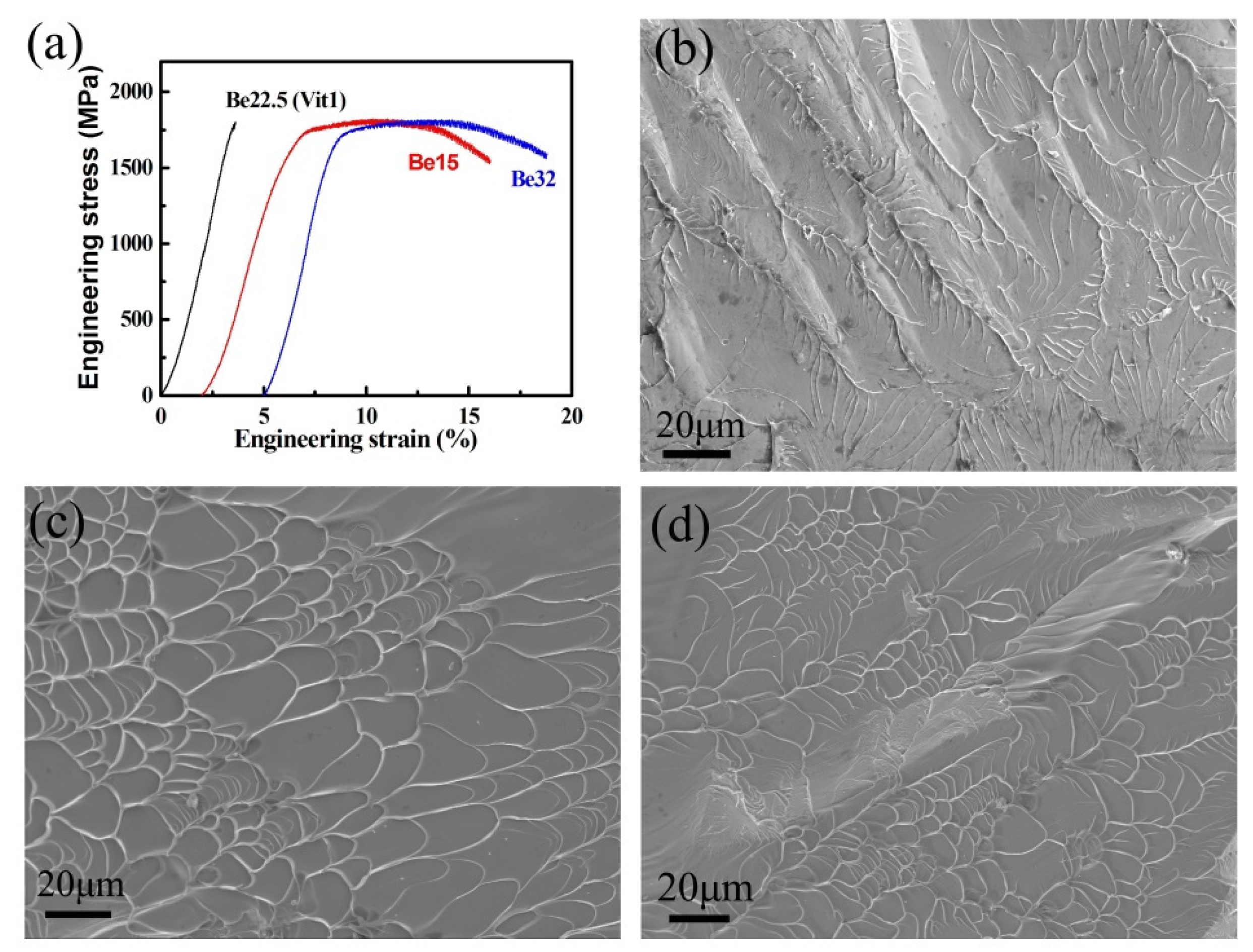Ductile Zr-Based Bulk Metallic Glasses by Controlling Heterogeneous Microstructure from Phase Competition Strategy
Abstract
:1. Introduction
2. Experimental Procedures
3. Results and Discussion
4. Conclusions
Author Contributions
Funding
Conflicts of Interest
References
- Wang, W.H.; Dong, C.; Shek, C.H. Bulk metallic glasses. Mater. Sci. Eng. R Rep. 2004, 44, 45–89. [Google Scholar] [CrossRef]
- Chen, M. A brief overview of bulk metallic glasses. NPG Asia Mater. 2011, 3, 82–90. [Google Scholar] [CrossRef] [Green Version]
- Hays, C.C.; Kim, C.P.; Johnson, W.L. Microstructure controlled shear band pattern formation and enhanced plasticity of bulk metallic glasses containing in situ formed ductile phase dendrite dispersions. Phys. Rev. Lett. 2000, 84, 2901–2904. [Google Scholar] [CrossRef] [PubMed] [Green Version]
- Conner, R.D.; Dandliker, R.B.; Johnson, W.L. Mechanical properties of Tungsten and steel fiber reinforced Zr41.2Ti13.8Cu12.5Ni10Be22.5 metallic glass matrix composites. Acta Mater. 1998, 46, 6089–6102. [Google Scholar] [CrossRef]
- Xiong, J.; Liu, Y.; Yu, A.S.; Liu, B.; Yu, K.; Huang, X.H.; Yang, X.J. Microstructure and mechanical properties of Ti48Zr18V12Cu5Be17 bulk metallic glass composite. J. Alloys Compd. 2018, 741, 1212–1221. [Google Scholar] [CrossRef]
- Cheng, J.L.; Wang, J.J.; Yun, Y.L.; Rui, J.X.; Zhao, W.; Li, F. A novel core-shell structure reinforced Zr-based metallic glass composite with combined high strength and good tensile ductility. J. Alloys Compd. 2019, 803, 413–416. [Google Scholar] [CrossRef]
- Liu, D.M.; Lin, S.F.; Ge, S.F.; Zhu, Z.W.; Fu, H.M.; Zhang, H.F. A Ti-based bulk metallic glass composite with excellent tensile properties and significant work-hardening capacity. Mater. Lett. 2018, 233, 107–110. [Google Scholar] [CrossRef]
- Cheng, J.L.; Chen, G.; Zhao, W.; Wang, Z.Z.; Zhang, Z.W. Enhancement of tensile properties by the solid solution strengthening of nitrogen in Zr-based metallic glass composites. Mater. Sci. Eng. A 2017, 696, 461–465. [Google Scholar] [CrossRef]
- Fan, C.; Li, C.F.; Inoue, A. Deformation behavior of Zr-based bulk nanocrystalline amorphous alloys. Phys. Rev. B 2000, 61, 3761–3763. [Google Scholar] [CrossRef]
- Yao, K.F.; Ruan, F.; Yang, T.Q.; Chen, N. Superductile bulk metallic glass. Appl. Phys. Lett. 2006, 88, 122106. [Google Scholar] [CrossRef]
- Liu, Y.H.; Wang, G.; Wang, R.J.; Pan, M.X.; Wang, W.H. Super Plastic Bulk Metallic Glasses at Room Temperature. Science 2007, 315, 1385–1388. [Google Scholar] [CrossRef] [PubMed]
- Qiao, J.C.; Wang, Q.; Pelletier, J.M.; Kato, H.; Casalini, R.; Crespo, D.; Pineda, E.; Yao, Y.; Yang, Y. Structural heterogeneities and mechanical behavior of amorphous alloys. Prog. Mater. Sci. 2019, 104, 250–329. [Google Scholar] [CrossRef]
- Park, T.G.; Kim, S.Y.; Ahn, H.S.; Oh, H.S.; Kim, D.H.; Chang, H.J.; Park, E.S. Tuning correlative atomic scale fluctuation and related properties in Ni–Nb–Zr metallic glasses. Acta Mater. 2019, 173, 53–60. [Google Scholar] [CrossRef]
- Cao, D.; Wu, Y.; Liu, X.J.; Wang, H.; Wang, X.Z.; Lu, Z.P. Enhancement of glass-forming ability and plasticity via alloying the elements having positive heat of mixing with Cu in Cu48Zr48Al4 bulk metallic glass. J. Alloys Compd. 2019, 777, 382–391. [Google Scholar] [CrossRef]
- Sikan, F.; Atabay, S.E.; Motallebzadeh, A.; Özerinç, S.; Kalay, I.; Kalay, Y.E. Effect of Sm on thermal and mechanical properties of Cu-Zr-Al bulk metallic glasses. Mater. Sci. Eng. A 2019, 743, 168–174. [Google Scholar] [CrossRef]
- Zhang, L.; Cheng, Y.Q.; Cao, A.J.; Xu, J.; Ma, E. Bulk metallic glasses with large plasticity: Composition design from the structural perspective. Acta Mater. 2009, 57, 1154–1164. [Google Scholar] [CrossRef]
- Kim, H.K.; Ahn, J.P.; Lee, B.J.; Park, K.W. Role of atomic-scale chemical heterogeneities in improving the plasticity of Cu-Zr-Ag bulk amorphous alloys. Acta Mater. 2018, 157, 209–217. [Google Scholar] [CrossRef]
- Xie, S.H.; Kruzic, J.J. Cold rolling improves the fracture toughness of a Zr-based bulk metallic glass. J. Alloys Compd. 2017, 694, 1109–1120. [Google Scholar] [CrossRef]
- Ebner, C.; Escher, B.; Gammer, C.; Eckert, J.; Pauly, S.; Rentenberger, C. Structural and mechanical characterization of heterogeneities in a CuZr-based bulk metallic glass processed by high pressure torsion. Acta Mater. 2018, 160, 147–157. [Google Scholar] [CrossRef]
- Zhang, Y.; Wang, W.H.; Greer, A.L. Making metallic glasses plastic by control of residual stress. Nat. Mater. 2006, 5, 857–860. [Google Scholar] [CrossRef]
- Tong, Y.; Dmowski, W.; Bei, H.; Yokoyama, Y.; Egami, T. Mechanical rejuvenation in bulk metallic glass induced by thermo-mechanical creep. Acta Mater. 2018, 148, 384–390. [Google Scholar] [CrossRef]
- Ketov, S.V.; Sun, Y.H.; Nachum, S.; Lu, Z.; Checchi, A.; Beraldin, A.R.; Bai, H.Y.; Wang, W.H.; Luzgin, D.V.L.; Carpenter, M.A.; et al. Rejuvenation of metallic glasses by non-affine thermal strain. Nature 2015, 524, 200–203. [Google Scholar] [CrossRef] [PubMed] [Green Version]
- Pan, J.; Wang, Y.X.; Guo, Q.; Zhang, D.; Greer, A.L.; Li, Y. Extreme rejuvenation and softening in a bulk metallic glass. Nat. Commun. 2018, 9, 560. [Google Scholar] [CrossRef] [PubMed]
- Su, S.; Lu, Y.Z. Laser directed energy deposition of Zr-based bulk metallic glass composite with tensile strength. Mater. Lett. 2019, 247, 79–81. [Google Scholar] [CrossRef]
- Yang, C.; Zhang, C.; Xing, W.; Liu, L. 3D printing of Zr-based bulk metallic glasses with complex geometries and enhanced catalytic properties. Intermetallics 2018, 94, 22–28. [Google Scholar] [CrossRef]
- Ida, H.; Seiryu, M.; Takeshita, N.; Iwasaki, M.; Yokoyama, Y.; Tsutsumi, Y.; Ikeda, E.; Sasaki, S.; Miyashita, S.; Sasaki, S.; et al. Biosafety, stability, and osteogenic activity of novel implants made of Zr70Ni16Cu6Al8 bulk metallic glass for biomedical application. Acta Biomater. 2018, 74, 505–517. [Google Scholar] [CrossRef]
- Cheng, J.L.; Chen, G.; Gao, P.; Liu, C.T.; Li, Y. The critical cooling rate and microstructure evolution of Zr41.2Ti13.8Cu12.5Ni10Be22.5 composites by Bridgman solidification. Intermetallics 2018, 18, 115–118. [Google Scholar] [CrossRef]
- Cheng, J.L.; Chen, G.; Fan, C.; Li, Y. Glass formation, microstructure evolution and mechanical properties of Zr41.2Ti13.8Cu12.5Ni10Be22.5 and its surrounding alloys. Acta Mater. 2014, 73, 194–204. [Google Scholar] [CrossRef]
- Zhou, W.; Hu, J.Q.; Weng, W.P.; Gao, L.Y.; Xu, G.Y. Enhancement of plasticity in Zr-Cu-Ni-Al-Ti bulk metallic glass by heterogeneous microstructure. J. Non-Cryst. Solids 2018, 481, 530–536. [Google Scholar] [CrossRef]
- Saida, J.; Li, C.; Matsushita, M.; Inoue, A. Investigation of the stability of glassy state in the Zr- and Hf-based glassy alloys correlated with their transformation behavior. J. Mater. Res. 2001, 16, 3389–3401. [Google Scholar] [CrossRef]
- Saida, J.; Inoue, A. Quasicrystals from glass devitrification. J. Non-Cryst. Solids 2003, 317, 97–105. [Google Scholar] [CrossRef]
- Sarac, B.; Ivanov, Y.P.; Chuvilin, A.; Schöberl, T.; Stoica, M.; Zhang, Z.L.; Eckert, J. Origin of large plasticity and multiscale effects in iron-based metallic glasses. Nat. Commun. 2018, 9, 1333. [Google Scholar] [CrossRef] [PubMed] [Green Version]
- Sun, P.; Peng, C.X.; Cheng, Y.; Zhang, G.; Wang, P.F.; Jia, L.J.; Wang, L. Mechanical behavior of CuZr dual-phase nanocrystal-metallic glass composites. Comp. Mater. Sci. 2019, 163, 290–300. [Google Scholar] [CrossRef]




© 2019 by the authors. Licensee MDPI, Basel, Switzerland. This article is an open access article distributed under the terms and conditions of the Creative Commons Attribution (CC BY) license (http://creativecommons.org/licenses/by/4.0/).
Share and Cite
Cheng, J.L.; Wang, J.J.; Rui, J.X.; Yun, Y.L.; Zhao, W.; Li, F. Ductile Zr-Based Bulk Metallic Glasses by Controlling Heterogeneous Microstructure from Phase Competition Strategy. Nanomaterials 2019, 9, 1728. https://doi.org/10.3390/nano9121728
Cheng JL, Wang JJ, Rui JX, Yun YL, Zhao W, Li F. Ductile Zr-Based Bulk Metallic Glasses by Controlling Heterogeneous Microstructure from Phase Competition Strategy. Nanomaterials. 2019; 9(12):1728. https://doi.org/10.3390/nano9121728
Chicago/Turabian StyleCheng, J. L., J. J. Wang, J. X. Rui, Y. L. Yun, W. Zhao, and F. Li. 2019. "Ductile Zr-Based Bulk Metallic Glasses by Controlling Heterogeneous Microstructure from Phase Competition Strategy" Nanomaterials 9, no. 12: 1728. https://doi.org/10.3390/nano9121728





